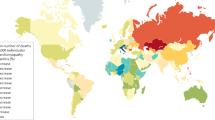Abstract
Cardiomyopathies are heart muscle diseases, which have been defined by their central hemodynamics and macropathology and divided in five major forms: dilated (DCM), hypertrophic (HCM), restrictive (RCM), right ventricular (RVCM), and nonclassifiable cardiomyopathies (NCCM). Furthermore, the most recent WHO/WHF definition also comprises, among the specific cardiomyopathies, inflammatory cardiomyopathy as a distinct entity, defined as myocarditis in association with cardiac dysfunction. Idiopathic, autoimmune, and infectious forms of inflammatory cardiomyopathy were recognized. Viral cardiomyopathy has been defined as viral persistence in a dilated heart. It may be accompanied by myocardial inflammation and then termed inflammatory viral cardiomyopathy (or viral myocarditis with cardiomegaly). If no inflammation is observed in the biopsy of a dilated heart (< 14 lymphocytes and macrophages/mm2), the term viral cardiomyopathy or viral persistence in DCM should be applied according to the WHF Task Force recommendations.
Within the German heart failure net it is the authors’ working hypothesis, that DCM shares genetic risk factors with other diseases of presumed autoimmune etiology and, therefore, the same multiple genes in combination with environmental factors lead to numerous different autoimmune diseases including DCM. Therefore, the authors’ primary goal is to acquire epidemiologic data of patients with DCM regarding an infectious and inflammatory etiology of the disease. Circumstantial evidence points to a major role of viral myocarditis in the etiology of DCM. The common presence of viral genetic material in the myocardium of patients with DCM provides the most compelling evidence, but proof of causality is still lacking. In addition, autoimmune reactions have been described in many studies, indicating them as an important etiologic factor. Nevertheless, data on the proportion of patients, in whom both mechanisms play a role are still missing.
A pivotal role for autoimmunity in a substantial proportion of patients with DCM is supported by the presence of organ-specific autoantibodies, inflammatory infiltrates and pro-inflammatory cytotoxic cytokines. Furthermore, familial occurrence of DCM has been described in about 20–30% of cases, with the presence of autoantibodies and abnormal cytokine profiles in first-degree relatives with asymptomatic left ventricular enlargement. This suggests the involvement of a disrupted humoral and cellular immunity early in the development of the disease. A similar pattern of humoral and cellular immune dysregulation has been described in other autoimmune diseases. There is considerable evidence that genetic factors play an important role in the pathogenesis of DCM, either as contributors to the susceptibility to environmental factors or as determinants of functional and structural changes that characterize the phenotypic expression of the disease.
Yet, it is not known whether the susceptibility to immunologically mediated myocardial damage reflects the presence of genetic risk factors shared by other autoimmune diseases. Preliminary investigations suggest, that this is the case, because the frequency of autoimmune disorders other than DCM was higher in first-degree relatives of the subjects with DCM including juvenile diabetes, rheumatoid arthritis, thyroiditis, psoriasis, and asthma.
The nature of the genetic risk is undetermined and probably involves genes in the major histocompatibility (MHC) locus as well as other susceptibility loci. Therefore, the authors started their investigation with the search for MHC class 2 DQ polymorphisms in the peripheral blood of patients with DCM in parallel to the search for new interesting susceptibility loci by the use of the microarray analysis regarding genes responsible for inflammatory and autoimmune diseases. By this approach a new insight in the familial clustering of other autoimmune diseases in patients with DCM and in genetic predisposition can be expected.
Zusammenfassung
Kardiomyopathien werden nach der letzten Klassifikation der WHO/ISFC-(WHF-)Task Force nach ihren makropathologischen und hämodynamischen Kriterien in fünf Formen eingeteilt: dilatative (DCM), hypertrophische (HCM), restriktive (RCM), rechtsventrikuläre (RVCM) und nicht klassifizierbare Herzmuskelerkrankungen (NCCM). Unter den spezifischen Kardiomyopathien wurde die inflammatorische Kardiomyopathie als Myokarditis mit hämodynamischer Dysfunktion eingereiht. Eine virale Kardiomyopathie wurde als Persistenz viralen Genoms bei einer DCM definiert, die mit einer histologisch validierten Entzündung einhergehen kann. Inflammation liegt nach den Empfehlungen der WHF-Task Force vor, wenn sich ≥ 14 Lymphozyten und Makrophagen/mm2 in einer Myokardbiopsie finden. Dann liegt eine virale inflammatorische Kardiomyopathie oder Virusmyokarditis vor.
Im Herzinsuffizienznetz geht das Projekt der Autoren von der Hypothese aus, dass die DCM ein genetisches Risikoprofil mit anderen Autoimmunkrankheiten teilt und deshalb verschiedene Gene (Polymorphismen) zusammen mit Umweltfaktoren zu autoimmunen Krankheitsbildern führen, zu denen auch die DCM zählt. Mit dieser Hypothese gut vereinbar sind der Nachweis von viraler DNA oder RNA im Myokard oder autoimmune Phänomene bei Patienten, z. T. auch ihren (noch) nicht betroffenen Angehörigen. Ungeklärt sind bisher allerdings die kausalen ätiopathogenetischen Verknüpfungen oder Trennlinien zwischen den beiden Befunden: So lassen sich bei einem Großteil der DCM-Patienten zirkulierende und biopsiegebundene organspezifische Autoantikörper, entzündliche Infiltrate und die Freisetzung proinflammatorischer Zytokine nachweisen. Andererseits ist anzunehmen, dass mindestens 20–30% der DCMs familiär gehäuft auftreten, allerdings ohne dass dabei in allen Fällen eine monogenetische Erkrankung vorliegen muss. Es ist anzunehmen, dass genetische Faktoren deshalb entweder als Suszeptibilitätsfaktoren für Umwelteinflüsse (wie eine Virusinfektion, Stress usw.) oder als direkte Determinanten des funktionellen und strukturellen Phänotyps Kardiomyopathie verantwortlich sind. Dabei ist es weiteren Untersuchungen vorbehalten zu klären, ob die Prädisposition für eine autoreaktive kardiale Schädigung sich derselben genetischen Mechanismen wie bei anderen Autoimmunerkrankungen bedient. Bemerkenswert ist die Prävalenz anderer autoimmuner Erkrankungen bei einem substantiellen Anteil von Indexpatienten mit DCM und Verwandten ersten Grades, wie z. B. juveniler Diabetes, Rheuma, Thyreoiditis, Psoriasis, Asthma usw., in eigenen bisherigen Untersuchungen.
Die Autoren leiten daraus ab, dass für die Abschätzung des genetisch prädisponierenden Risikos auch Gene des MHC („major histocompatibility complex“) eine Rolle spielen, und haben sich in einem ersten Ansatz deren Untersuchung vorgenommen.
Similar content being viewed by others
Author information
Authors and Affiliations
Consortia
Corresponding author
Rights and permissions
About this article
Cite this article
Maisch, B., Richter, A., Sandmöller, A. et al. Inflammatory Dilated Cardiomyopathy (DCMI). Herz 30, 535–544 (2005). https://doi.org/10.1007/s00059-005-2730-5
Issue Date:
DOI: https://doi.org/10.1007/s00059-005-2730-5




